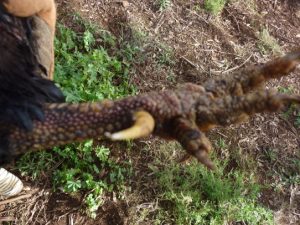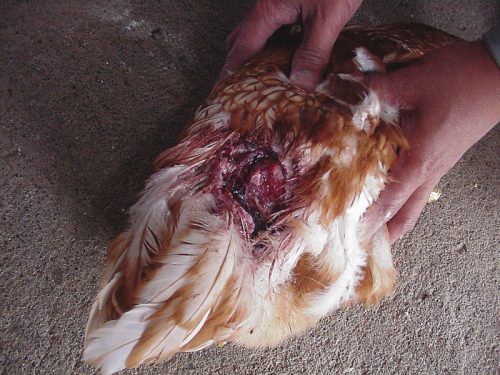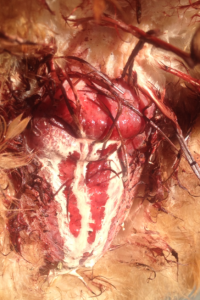Common problems and treatment methods for backyard chickens
Common problems and treatment methods for backyard chickens
Common health and welfare issues associated with backyard poultry include worms, rodents, mites, egg binding, prolapse, cannibalism, nutritional deficiencies, and impacted crop and gizzard. There are detailed instructions for treatment of worms, mites and diseases. This article covers some of the most commonly found problems in backyard birds and outlines treatment methods in a very general manner. For proper care and treatment of your birds, you are strongly recommended to see your local veterinarian for advice.
Egg bound hens
Cause
Egg binding occurs when a hen fails to lay the egg. There are numerous reasons for it but often the egg may be too large, the hen is too weak due to disease or nutrient deficiencies, in particular, calcium deficiency. The symptoms for egg binding are easy to spot because the bulge at the pelvis is visible and the hen usually moves restlessly in and out of the nest or may stand in a corner looking sick. If it is not attended to quickly, the hen can die.
Treatment
If the bulge is not too large and the hen is reasonably active, then giving the hen a warm bath (15-30 minutes) and electrolytes containing soluble calcium might relax her muscles enough for her to lay the egg. If the egg is too big for the pelvis of the bird, the only option is to carefully prick the egg with a large syringe, draw the yolk out to collapse the egg, and take out the membrane with the shell.
Scaly legs
Cause

Scaly legs are a very common problem in backyard poultry. They are caused by tiny parasites (mites) which live off the tissues underneath the scales of the legs and feet. The droppings of the mites build up to form a thick crust on the legs and feet of the bird. The mites spread from bird to bird within a backyard and are highly irritable and damaging to the bird.
Treatment
All home remedies are based on the fact that the mites need air to live, so suffocation is a very effective method. This involves cutting off the air supply to the infected areas and the easiest way to do this is to use some sort of oil. First, clean the legs and feet with lukewarm water, and then either evenly apply Vaseline over the infected areas or dip the legs in vegetable oil for 20 second. Repeat this daily for 7-10 days and the problem will disappear.

Nutrient deficiencies
Chickens require many nutrients, including energy, amino acids, fatty acids, minerals and vitamins. A complete feed should contain all the nutrients in appropriate amounts to satisfy the nutrient requirements of the bird.
For instance, each day a hen requires around 300 kcal energy, 20g protein, 4g calcium, 2g phosphorus and very small amounts of trace minerals and vitamins. The energy comes mainly from cereal grains and fat sources, whereas amino acids are supplied through proteins, which come from peas, beans, and meat and bone meal. A hen with a bodyweight of less than 2kg lays an egg just about every day, which weighs 60-70g and represents 2.3-2.7g calcium.
These are the examples of the so-called macronutrients. Micronutrients, such as vitamins and trace minerals are needed in minute quantities but are essential for life functions of the hen and must be supplied through the diet. Failure to do so leads to all sorts of nutrient deficiencies, which compromise the health and wellbeing of the animal.
In a backyard situation, many people think that a simple provision of grain and kitchen scraps is enough to raise poultry. It is often not so.
Firstly, a single grain source cannot provide all the nutrients required by the bird. For instance, one kilogram of corn contains approximately 3300kcal energy, 90g protein and 0.2g calcium. A hen in a backyard consumes around 120g feed per day, so the daily intakes of energy, protein and calcium from corn alone are 396 kcal, 10.8g protein and 0.024g calcium. Although the corn provides more than enough energy, it does not contain sufficient amounts of protein or calcium to meet the bird’s needs. In fact, on a corn only diet, energy supply is 132%, protein is 54% and calcium is 0.6% of the hen’s requirements. In addition, there would be many other deficiencies including the first limiting amino acid, methionine, and most of the vitamins and trace minerals.
Secondly, some people argue that kitchen scraps and other “foods” available in the environment, such as insects and grass will be enough to meet the requirements. This is a myth since (a) most backyards are not large enough to guarantee a continuous supply of insects and worms; (b) poultry species cannot digest grass to obtain sufficient amounts of nutrients even if there is plenty of grass, and (c) depending on the location and season, vegetation in a typical backyard is depleted very quickly, even by a few chickens.
Thus, it is essential to supply a variety of feed sources to the backyard hens, preferably properly formulated complete feed, to prevent nutrient deficiencies. Nutrient deficiencies lead to health and welfare issues, and in severe cases, even death.
Impacted, blocked, pendulous, sour crop and gizzard

Coiled grass in an impacted gizzard
Cause
The crop of birds stores food whereas the gizzard grinds it for downstream digestion. Sometimes, hens consume long, fibrous grasses or feathers that coil up in the crop, stopping food from going through to the rest of the gastrointestinal tract. When the content stays in the crop for a number of days, it starts to ferment. It then gives off a pungent acidic odour, and hence the name “sour crop”. The same phenomenon also occurs in the gizzard.
The occurrence of crop and gizzard impaction is most frequent when hens are kept on long, green pastures. It leads to severe loss of condition in sub-clinical cases, and frequently, total starvation resulting in death.
Treatment
Prevention, rather than treatment, is probably the best approach when it comes to crop and gizzard impaction in poultry. For instance, keeping grass on the range short by cutting it regularly, and offering feed with a high level of structural materials, such as whole grain and oat hulls, to modulate gut development and function may be helpful. In terms of treatment, anecdotal evidence suggests that giving birds vinegar or commercial acidifiers in their drinking water could alleviate the situation.

Bird seriously injured through pecking
Cannibalism
Cannibalism is a form of aggressive pecking that can occur in both commercial and backyard poultry.
A detailed description of the cause and treatment of cannibalism is available at another section the

website Hub under Cannibalism (or aggressive pecking)
Cannibalism is a major welfare issue and it must be dealt with promptly. In backyard poultry production, it is usually a consequence of other issues, such as prolapse and egg binding. A few aggressive birds can destroy a prolapsed bird very quickly if that bird is not isolated immediately.

